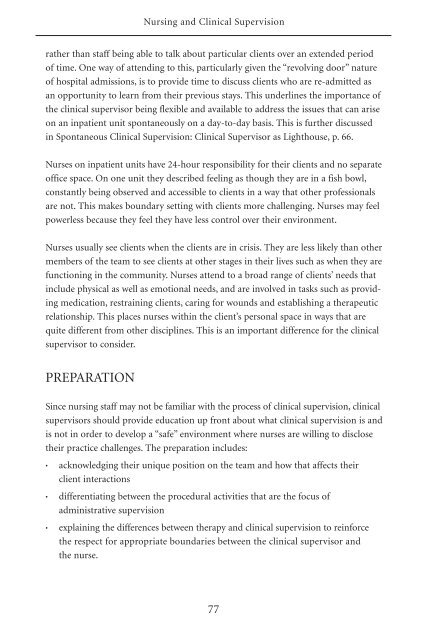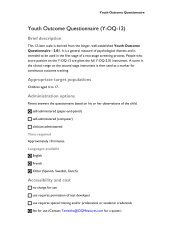Clinical Supervision Handbook - CAMH Knowledge Exchange ...
Clinical Supervision Handbook - CAMH Knowledge Exchange ...
Clinical Supervision Handbook - CAMH Knowledge Exchange ...
You also want an ePaper? Increase the reach of your titles
YUMPU automatically turns print PDFs into web optimized ePapers that Google loves.
ather than staff being able to talk about particular clients over an extended period<br />
of time. One way of attending to this, particularly given the “revolving door” nature<br />
of hospital admissions, is to provide time to discuss clients who are re-admitted as<br />
an opportunity to learn from their previous stays. This underlines the importance of<br />
the clinical supervisor being flexible and available to address the issues that can arise<br />
on an inpatient unit spontaneously on a day-to-day basis. This is further discussed<br />
in Spontaneous <strong>Clinical</strong> <strong>Supervision</strong>: <strong>Clinical</strong> Supervisor as Lighthouse, p. 66.<br />
Nurses on inpatient units have 24-hour responsibility for their clients and no separate<br />
office space. On one unit they described feeling as though they are in a fish bowl,<br />
constantly being observed and accessible to clients in a way that other professionals<br />
are not. This makes boundary setting with clients more challenging. Nurses may feel<br />
powerless because they feel they have less control over their environment.<br />
Nurses usually see clients when the clients are in crisis. They are less likely than other<br />
members of the team to see clients at other stages in their lives such as when they are<br />
functioning in the community. Nurses attend to a broad range of clients’ needs that<br />
include physical as well as emotional needs, and are involved in tasks such as providing<br />
medication, restraining clients, caring for wounds and establishing a therapeutic<br />
relationship. This places nurses within the client’s personal space in ways that are<br />
quite different from other disciplines. This is an important difference for the clinical<br />
supervisor to consider.<br />
PREPARATION<br />
Nursing and <strong>Clinical</strong> <strong>Supervision</strong><br />
Since nursing staff may not be familiar with the process of clinical supervision, clinical<br />
supervisors should provide education up front about what clinical supervision is and<br />
is not in order to develop a “safe” environment where nurses are willing to disclose<br />
their practice challenges. The preparation includes:<br />
• acknowledging their unique position on the team and how that affects their<br />
client interactions<br />
• differentiating between the procedural activities that are the focus of<br />
administrative supervision<br />
• explaining the differences between therapy and clinical supervision to reinforce<br />
the respect for appropriate boundaries between the clinical supervisor and<br />
the nurse.<br />
77

















